
With the rush to the beach or getting time away after two years of COVID-induced lockdowns, you might have missed the news of Amazon’s most recent acquisition this summer.
On 21 July,
Amazon announced that it had acquired
One Medical, in a
cash deal valued at $3.9 billion.
One Medical is a membership-based primary care practice which provides healthcare to patients through a combination of in-person, digital and virtual care services in locations across the U.S.
The company is using technology to drive innovation in primary healthcare such as by allowing online booking for GP appointments or text messaging with doctors, in addition to 24/7 on demand tele-healthcare. It has also built its own medical records technology from the ground up to help doctors better manage patient relationships.
One Medical was one of the earliest companies in the U.S. to recognise the enormous potential of technology to improve both access to and quality of healthcare.
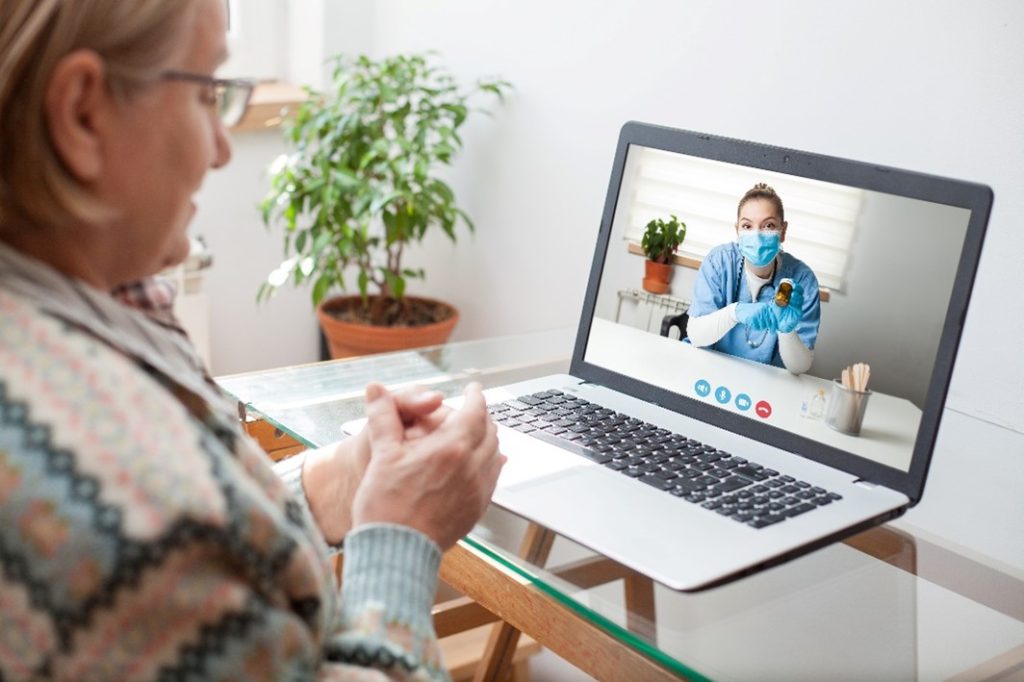
Amazon’s SVP of Health Services, Neil Lindsay, summed up the opportunity when he noted:
“…. healthcare is high on the list of experiences that need reinvention.”
“Booking an appointment, waiting weeks or even months to be seen, taking time off work, driving to a clinic, finding a parking spot, waiting in the waiting room then the exam room for what is too often a rushed few minutes with a doctor, then making another trip to a pharmacy – we see lots of opportunity to both improve the quality of the experience and give people back valuable time in their days”
While the agreement was met with some discussion around the risk of Big Tech and the privacy of patient health information, it equally met with optimistic commentary on the ability of Amazon to bring much-needed efficiencies and improved customer experience to health care, as it has to retail shopping.
The caveat is that the healthcare is different from purchasing new trainers given its nature and the fact that some costs just cannot be squeezed. But its’ certainly true that technology, and the high-quality broadband connectivity upon which it is based, can fundamentally change how healthcare is delivered and how patients experience it.
Primary care is just Amazon’s latest move into health care. The company acquired online pharmacy PillPack in 2018 for over $700 million and launched its own online prescription delivery service Amazon Pharmacy in 2020. There are also rumours that Amazon is considering starting a new digital therapy and counselling platform.
Whether, or not, Amazon’s foray into healthcare is the commoditisation of health and whether that’s a good or bad thing is beside the point. The truth is that as Neil Lindsay put it “
healthcare is high on the list of experiences that need reinvention.”
Technology across all aspects of our lives has put power back in the hands of people, broken down unnatural and societal barriers to equality of access in areas as diverse as education, travel or share trading.

Yet healthcare, particularly patient experience of accessing care, remains one of the few sectors where the impact of connectivity and digital technologies doesn’t appear to have made as much cut through.
While most activities can be booked online such as a haircut or an NCT for a car, why not an appointment with a GP? Equally, in Ireland’s hospital system there is no single digital health record for each patient to provide a catch-all record of a patient’s lifelong medical history. Instead, 85% of all hospital records remain paper-based and hospitals can’t access GP data and vice versa.
85% of all hospital records are still paper based.
Accelerated changed and faster digital uptake in healthcare is achievable. The pandemic showed us what’s possible, albeit in response to an emergency situation.
The rollout of the Covid-19 vaccination programme was predominantly over a digital platform. The move to e-prescriptions also during the pandemic – stalled for years prior to that - rapidly simplified and enhanced prescription practices overnight.
Patients, too, managed to successfully navigate both processes.
The digital win’s during COVID in Irish healthcare can continue. With groups like the Irish Digital Health Leadership Group, a collective of health, IT and patient experts, looking to accelerate the timelines for delivery.
In Ireland we have a wealth of health tech companies, many who are world leaders in their field whose expertise can be tapped into to develop local solutions for Irish patients.
Examples include,
SilverCloudHealth, which has delivered online mental health programmes to over a million individuals and 500 organisations globally, including in Ireland.
LetsGetChecked is another Irish-grown company making waves in healthcare internationally. The company offers more than 30 home diagnostic tests in the categories of sexual health, women’s health, men’s health, wellness and coronavirus, with more than seven million tests delivered worldwide to date. In addition, in the U.S. its’ users can order medication online.
Health Beacon, a patient medication management system, is just another further example of an Irish company growing rapidly overseas. Added to these is the strong presence of global med-tech and pharma FDA companies dotted across Ireland, all whose expertise could be brought to bear.
The Government has set a target of all homes and businesses having access to a Gigabit network by 2028. Through the work of commercial broadband network operators such as
SIRO or
National Broadband Ireland people in every corner of Ireland will have reliable and secure connectivity.
At a time in Ireland when wait times for accessing health services can be long, reinventing healthcare delivery and expanding investment in digital health services could offer a solution to ensure faster access to care for many.
[lookup_modal type="eircode" button-text="Search Your Eircode Today" position="mid" title="Search Your Eircode Today"]
 It’s that time of year where students big and small return to school with heavy backpacks and refreshed minds, while parents feel relieved that routine and lessons are back. We’re used to the regular checklist of back-to-school with pens, paper, and countless books, but what about a reliable broadband connection?
The pandemic demonstrated how connectivity supported the education sector, with classes pivoting online via video call platforms such as Zoom and Microsoft Teams. Teachers and students alike showcased agility while traversing a new way of learning. In 2021, SIRO’s Director of People and Culture Blanaid O’Regan wrote about how e-learning is transforming the delivery of education, and the need to learn from the pandemic experiences – good and bad – and build on them.
At the same time, Ireland’s Department of Education was finalising its Digital Strategy for Education. In April 2022, it was published. It’s a five-year strategy to 2027 and follows on from its’ predecessor which concluded in 2020.
Digital learning is about using digital technologies and tools in a variety of ways and location, whether as a group or individual, in the classroom, at home or in other settings.
It’s that time of year where students big and small return to school with heavy backpacks and refreshed minds, while parents feel relieved that routine and lessons are back. We’re used to the regular checklist of back-to-school with pens, paper, and countless books, but what about a reliable broadband connection?
The pandemic demonstrated how connectivity supported the education sector, with classes pivoting online via video call platforms such as Zoom and Microsoft Teams. Teachers and students alike showcased agility while traversing a new way of learning. In 2021, SIRO’s Director of People and Culture Blanaid O’Regan wrote about how e-learning is transforming the delivery of education, and the need to learn from the pandemic experiences – good and bad – and build on them.
At the same time, Ireland’s Department of Education was finalising its Digital Strategy for Education. In April 2022, it was published. It’s a five-year strategy to 2027 and follows on from its’ predecessor which concluded in 2020.
Digital learning is about using digital technologies and tools in a variety of ways and location, whether as a group or individual, in the classroom, at home or in other settings.
 Embedding digital technologies and adopting digital approaches to classroom learning in our primary and post-primary education system is both a huge challenge and opportunity. To ensure that the new strategy was fit for purpose, the Department, wisely, commissioned a review of the previous Strategy.
While there were many positives, it also exposed the work still be completed. This included the fact that digital technologies were not a feature of teaching and learning in 45% and 38% of primary and post-primary schools. That many teachers still struggled to access the professional development needed to deploy digital technologies was another standout finding.
In contrast, where digital technologies were well embedded it was held that, “having access to high-speed and dependable broadband was one of the key supporting factors.”
To be fair, the new Strategy is working to address the imbalance between those in our education system with reliable broadband and those without high quality access.
It has set a target that all primary and post-primary schools will have access to a minimum of 100 Mbps and 200 Mbps respectively by 2023. This will be realised by a range of financial measures, including a €15 million per annum broadband fund.
The commitment to have a further funding envelope to allow for further broadband speed upgrades is also welcome and necessary. This is particularly the case where Gigabit speeds are fast becoming the norm as the footprint of fibre broadband stretches ever further across Ireland.
Having the backbone for digital technologies - reliable, high quality and future proofed broadband connectivity - is, without question, key. But so too is ensuring our schools have access to the expertise to deploy it in the correct way, maximise its potential and be sufficiently knowledgeable to troubleshoot when required.
Embedding digital technologies and adopting digital approaches to classroom learning in our primary and post-primary education system is both a huge challenge and opportunity. To ensure that the new strategy was fit for purpose, the Department, wisely, commissioned a review of the previous Strategy.
While there were many positives, it also exposed the work still be completed. This included the fact that digital technologies were not a feature of teaching and learning in 45% and 38% of primary and post-primary schools. That many teachers still struggled to access the professional development needed to deploy digital technologies was another standout finding.
In contrast, where digital technologies were well embedded it was held that, “having access to high-speed and dependable broadband was one of the key supporting factors.”
To be fair, the new Strategy is working to address the imbalance between those in our education system with reliable broadband and those without high quality access.
It has set a target that all primary and post-primary schools will have access to a minimum of 100 Mbps and 200 Mbps respectively by 2023. This will be realised by a range of financial measures, including a €15 million per annum broadband fund.
The commitment to have a further funding envelope to allow for further broadband speed upgrades is also welcome and necessary. This is particularly the case where Gigabit speeds are fast becoming the norm as the footprint of fibre broadband stretches ever further across Ireland.
Having the backbone for digital technologies - reliable, high quality and future proofed broadband connectivity - is, without question, key. But so too is ensuring our schools have access to the expertise to deploy it in the correct way, maximise its potential and be sufficiently knowledgeable to troubleshoot when required.
 The benefits of digital learning not only extend to primary and post-primary, but for all levels. Third level institutions have long offered flexible learning options through online courses for those working full time.
The tendency to rely on the sole teacher who is “good with technology” is something specifically called out in the Strategy and sensibly the Department is now looking to examine new procurement mechanisms to give all schools access to technology experts.
When it comes to the delivery of education, it is not just as simple as online/remote vs. classroom learning and numerous studies examining which approach works best have shown different findings, depending on who or what was being asked.
Digital learning is about using digital technologies and tools in a variety of ways and locations, whether as a group or individual, in the classroom, at home or in other settings. What does matter hugely is digital literacy and adoption by students, teachers, and their parents too.
The benefits of digital learning not only extend to primary and post-primary, but for all levels. Third level institutions have long offered flexible learning options through online courses, including for those working full time. This demand for e-learning at further and higher-level educational settings looks set to grow.
During the current accommodation crisis facing students, while far from ideal, online education may be the difference for some between pursuing their course albeit online or not at all.
The new Digital Strategy for Education will make a significant contribution to improving the access to digital technologies in school setting and with-it digital literacy. However, the other vital cog in the wheel is to ensure high quality connectivity in the home.
For parents, having a reliable, steady, internet connection removes any stress from the learning process, so you and your child can focus on the homework at hand. The broadband landscape is changing on a monthly basis and the availability of high speed, future proofed broadband is reaching more areas day-by-day. If fibre broadband wasn’t an option when the last school year kicked off, just 12 months ago, it may be now.
It’s always worth checking your Eircode to confirm availability in your area, for your peace of mind and your kids!
The benefits of digital learning not only extend to primary and post-primary, but for all levels. Third level institutions have long offered flexible learning options through online courses for those working full time.
The tendency to rely on the sole teacher who is “good with technology” is something specifically called out in the Strategy and sensibly the Department is now looking to examine new procurement mechanisms to give all schools access to technology experts.
When it comes to the delivery of education, it is not just as simple as online/remote vs. classroom learning and numerous studies examining which approach works best have shown different findings, depending on who or what was being asked.
Digital learning is about using digital technologies and tools in a variety of ways and locations, whether as a group or individual, in the classroom, at home or in other settings. What does matter hugely is digital literacy and adoption by students, teachers, and their parents too.
The benefits of digital learning not only extend to primary and post-primary, but for all levels. Third level institutions have long offered flexible learning options through online courses, including for those working full time. This demand for e-learning at further and higher-level educational settings looks set to grow.
During the current accommodation crisis facing students, while far from ideal, online education may be the difference for some between pursuing their course albeit online or not at all.
The new Digital Strategy for Education will make a significant contribution to improving the access to digital technologies in school setting and with-it digital literacy. However, the other vital cog in the wheel is to ensure high quality connectivity in the home.
For parents, having a reliable, steady, internet connection removes any stress from the learning process, so you and your child can focus on the homework at hand. The broadband landscape is changing on a monthly basis and the availability of high speed, future proofed broadband is reaching more areas day-by-day. If fibre broadband wasn’t an option when the last school year kicked off, just 12 months ago, it may be now.
It’s always worth checking your Eircode to confirm availability in your area, for your peace of mind and your kids! 
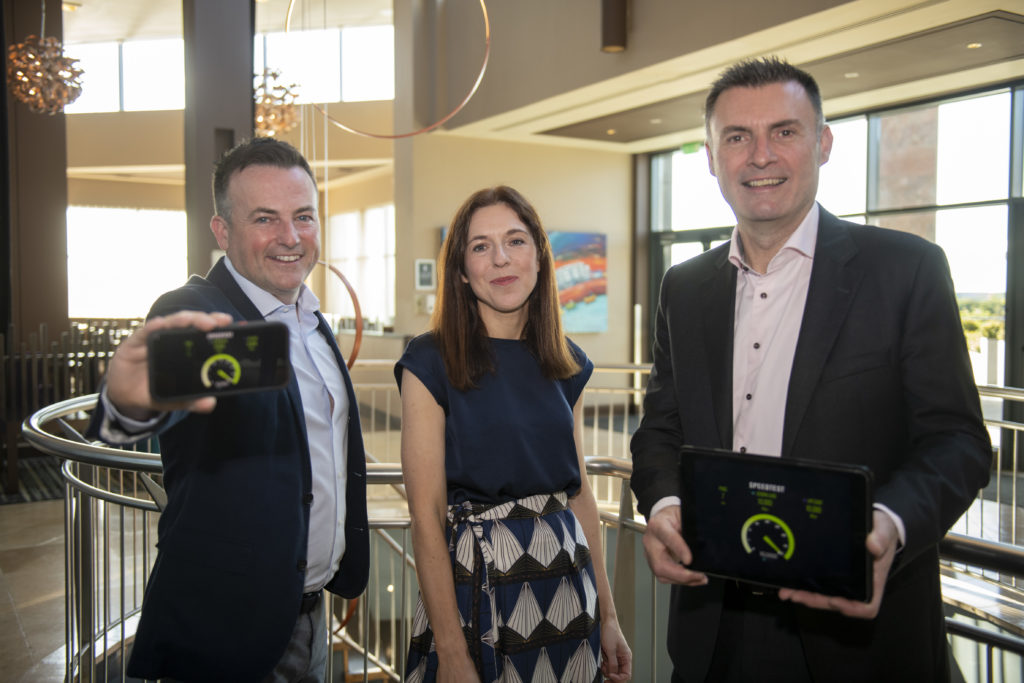 SIRO, a joint venture between ESB and Vodafone, is currently rolling out a 100% fibre broadband network across 154 towns and cities across Ireland, with services currently available to 450,000+ premises and reaching 770,000 premises over the next four years.
In October 2021, SIRO launched 2 Gigabit speeds for the residential market. Today’s announcement of 10 Gigabits is initially focused on the enterprise market. The latter have a need to progressively scale up their bandwidth from 2 Gigabits up to 10 Gigabits in the short to medium term.
The upgrade to 10 Gigabits reflects SIRO’s ambition to continuously bring innovation to the Irish broadband market. SIRO is Ireland’s sole open-access wholesale-only broadband operator and was first to introduce 1 Gigabit broadband to Irish homes. It is now stretching its offering further with speeds of 2 Gigabits for residential and up to 10 Gigabits for enterprise customers, respectively.
The benefits of multi-gigabit speeds include:
Ensure fastest speeds: Symmetrical speeds up to ten times faster than the best standard currently available of up to 1 Gigabit. A 10 Gigabit connection can transfer 1 Gigabit of data in 0.8 seconds or upload a file of 20 Gigabits in under 20 seconds.
Provide scalable connectivity: A future-proofed connection to support the increasing number of connected devices used by businesses.
Enhance cyber protection: Enhanced data and network protection by facilitating network management systems which reduce cybersecurity risks.
Support new technologies: The bandwidth to integrate emerging technologies, including artificial intelligence, virtual reality, 3D technology or voice recognition tools.
Commenting on the announcement, SIRO CEO, John Keaney, said:
“For SIRO, completing our transition to a 10 Gigabit-enabled network is about ensuring we continue to lead the market in terms of delivering on Ireland’s future broadband needs for the decades ahead.
“All aspects of business processes and operations are increasingly digitised. Reliable and future proofed connectivity is the foundation upon which they all rest.
“This upgrade gives enterprises the opportunity to plan and scale up their bandwidth requirements as their data demands and business requirements grow.
Rather than wait for the broadband infrastructure to catch up, businesses can now have the certainty that they can access higher speeds and capacity as and when they need it,” added Mr. Keaney.
To find out if you can avail of 10 Gigabit today, check your Eircode today!
[lookup_modal type="eircode" button-text="Search Your Eircode Today" position="mid" title="Search Your Eircode Today"]
SIRO, a joint venture between ESB and Vodafone, is currently rolling out a 100% fibre broadband network across 154 towns and cities across Ireland, with services currently available to 450,000+ premises and reaching 770,000 premises over the next four years.
In October 2021, SIRO launched 2 Gigabit speeds for the residential market. Today’s announcement of 10 Gigabits is initially focused on the enterprise market. The latter have a need to progressively scale up their bandwidth from 2 Gigabits up to 10 Gigabits in the short to medium term.
The upgrade to 10 Gigabits reflects SIRO’s ambition to continuously bring innovation to the Irish broadband market. SIRO is Ireland’s sole open-access wholesale-only broadband operator and was first to introduce 1 Gigabit broadband to Irish homes. It is now stretching its offering further with speeds of 2 Gigabits for residential and up to 10 Gigabits for enterprise customers, respectively.
The benefits of multi-gigabit speeds include:
Ensure fastest speeds: Symmetrical speeds up to ten times faster than the best standard currently available of up to 1 Gigabit. A 10 Gigabit connection can transfer 1 Gigabit of data in 0.8 seconds or upload a file of 20 Gigabits in under 20 seconds.
Provide scalable connectivity: A future-proofed connection to support the increasing number of connected devices used by businesses.
Enhance cyber protection: Enhanced data and network protection by facilitating network management systems which reduce cybersecurity risks.
Support new technologies: The bandwidth to integrate emerging technologies, including artificial intelligence, virtual reality, 3D technology or voice recognition tools.
Commenting on the announcement, SIRO CEO, John Keaney, said:
“For SIRO, completing our transition to a 10 Gigabit-enabled network is about ensuring we continue to lead the market in terms of delivering on Ireland’s future broadband needs for the decades ahead.
“All aspects of business processes and operations are increasingly digitised. Reliable and future proofed connectivity is the foundation upon which they all rest.
“This upgrade gives enterprises the opportunity to plan and scale up their bandwidth requirements as their data demands and business requirements grow.
Rather than wait for the broadband infrastructure to catch up, businesses can now have the certainty that they can access higher speeds and capacity as and when they need it,” added Mr. Keaney.
To find out if you can avail of 10 Gigabit today, check your Eircode today!
[lookup_modal type="eircode" button-text="Search Your Eircode Today" position="mid" title="Search Your Eircode Today"]  The rollout in Ballinasloe and Loughrea is part of SIRO’s ongoing roll out in Galway city and county. The company has already made its full fibre broadband network available to over 33,000 homes and businesses in Galway city. The investment is part of the company’s ongoing fibre rollout across Ireland, targeting 154 cities and towns and 770,000 premises.
Areas within Ballinasloe that will be connected include (but are not limited to): Townparks, Portnick, Poolboy, Dunlo, Kilgarve, Church Street, Bóthar Sáirséal, Meadowbrook, Beechlawn, Esker Hills.
Areas within Loughrea that will be connected include (but are not limited to): Portumna Road, Danesfort, Barrack Street, Abbey Street, Athenry Road, Ashlawn, Galway Road, Gort Road, Main Street, Cosmona, and The Hill.
SIRO’s network in Ballinasloe, Loughrea and Galway City is a 10 Gigabit-enabled network, which means that
The rollout in Ballinasloe and Loughrea is part of SIRO’s ongoing roll out in Galway city and county. The company has already made its full fibre broadband network available to over 33,000 homes and businesses in Galway city. The investment is part of the company’s ongoing fibre rollout across Ireland, targeting 154 cities and towns and 770,000 premises.
Areas within Ballinasloe that will be connected include (but are not limited to): Townparks, Portnick, Poolboy, Dunlo, Kilgarve, Church Street, Bóthar Sáirséal, Meadowbrook, Beechlawn, Esker Hills.
Areas within Loughrea that will be connected include (but are not limited to): Portumna Road, Danesfort, Barrack Street, Abbey Street, Athenry Road, Ashlawn, Galway Road, Gort Road, Main Street, Cosmona, and The Hill.
SIRO’s network in Ballinasloe, Loughrea and Galway City is a 10 Gigabit-enabled network, which means that 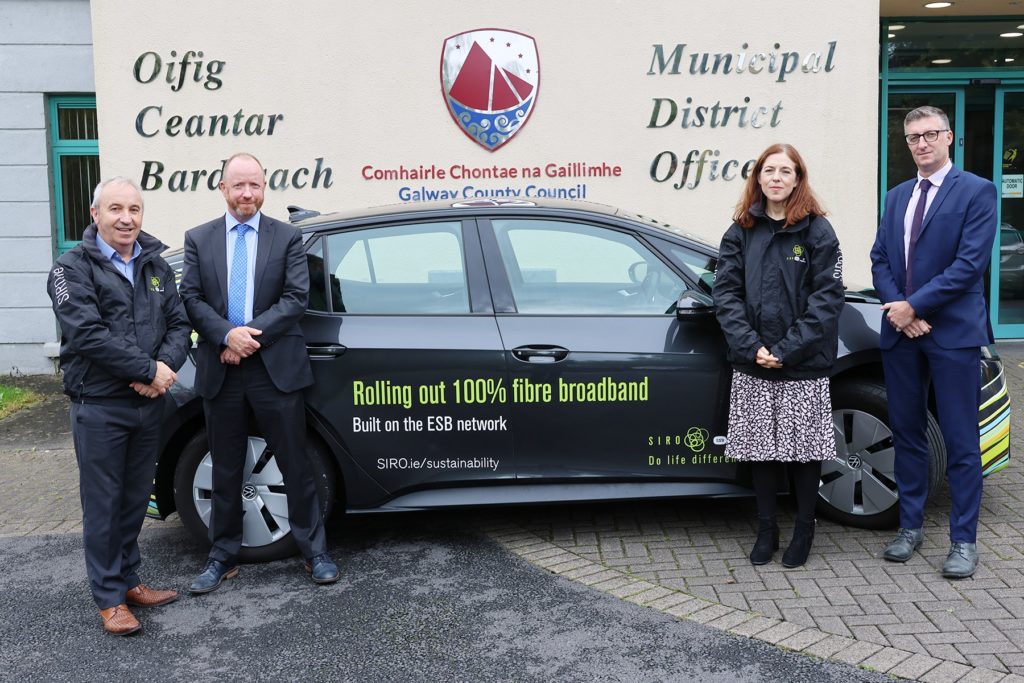 SIRO is a joint venture company between ESB and Vodafone, founded in 2015. SIRO’s state-of-the-art fibre broadband network is built on the ESB electricity infrastructure, trusted for its reliability and resilience. Overall, the company is investing more than €1 billion in delivering high speed, future proofed broadband across Ireland.
Commenting on the launch in Ballinasloe and Loughrea, SIRO CEO John Keaney said:
“Since we first started rolling out our network in Galway city, over four years ago demand has been strong for SIRO’s fibre broadband service. Our expansion now to Loughrea and Ballinasloe reflects the broader demand across Galway – city and county.
“Reliable, resilient and future proofed broadband is a game changer for regional towns and having access to SIRO’s network will create huge investment and job creation opportunities for towns such as Ballinasloe and Loughrea.
“SIRO is pleased to support this objective and to play a part in giving individuals and businesses a choice about where and how they live and work. We have had positive engagement with local stakeholders on the ground in both towns and we are now excited about getting on with our roll-out and connection process in the months ahead,” added Mr. Keaney.
Welcoming today’s announcement from SIRO, Galway County Council Chief Executive Jim Cullen stated:
“The building of these fibre networks will be a significant investment in these two towns.
The delivery of such infrastructure is a key economic enabler for existing business, with the potential to help increase their online presence and to trade online nationally and internationally.
“It will have positive impacts for both towns around growth, economic spin off effects & makes these towns more attractive for future investment.
“It will open up opportunities for citizens to work locally, with the delivery of high-speed connectivity, as remote working becomes more realistic for larger numbers of people, which should lead to a lowering of the towns carbon footprints and the residents of these towns will have more choice on broadband service provision in the future,” added Mr Cullen
SIRO as an open access wholesaler, partners with twenty broadband retailers across Ireland, to ensure that customers and businesses enjoy greater choice and competition.
Retailers offering SIRO residential, or enterprise broadband products include: Digiweb, Blacknight, Airwire, Sky, Vodafone, Virgin, Fastcom, Telcom, Viatel and Pure Telecom.
To register your interest, and to find out when SIRO will become available to your home or business, click here
[mailchimp_modal button-text="Register Your Interest" title="Sign Up Form" position="mid"]
SIRO is a joint venture company between ESB and Vodafone, founded in 2015. SIRO’s state-of-the-art fibre broadband network is built on the ESB electricity infrastructure, trusted for its reliability and resilience. Overall, the company is investing more than €1 billion in delivering high speed, future proofed broadband across Ireland.
Commenting on the launch in Ballinasloe and Loughrea, SIRO CEO John Keaney said:
“Since we first started rolling out our network in Galway city, over four years ago demand has been strong for SIRO’s fibre broadband service. Our expansion now to Loughrea and Ballinasloe reflects the broader demand across Galway – city and county.
“Reliable, resilient and future proofed broadband is a game changer for regional towns and having access to SIRO’s network will create huge investment and job creation opportunities for towns such as Ballinasloe and Loughrea.
“SIRO is pleased to support this objective and to play a part in giving individuals and businesses a choice about where and how they live and work. We have had positive engagement with local stakeholders on the ground in both towns and we are now excited about getting on with our roll-out and connection process in the months ahead,” added Mr. Keaney.
Welcoming today’s announcement from SIRO, Galway County Council Chief Executive Jim Cullen stated:
“The building of these fibre networks will be a significant investment in these two towns.
The delivery of such infrastructure is a key economic enabler for existing business, with the potential to help increase their online presence and to trade online nationally and internationally.
“It will have positive impacts for both towns around growth, economic spin off effects & makes these towns more attractive for future investment.
“It will open up opportunities for citizens to work locally, with the delivery of high-speed connectivity, as remote working becomes more realistic for larger numbers of people, which should lead to a lowering of the towns carbon footprints and the residents of these towns will have more choice on broadband service provision in the future,” added Mr Cullen
SIRO as an open access wholesaler, partners with twenty broadband retailers across Ireland, to ensure that customers and businesses enjoy greater choice and competition.
Retailers offering SIRO residential, or enterprise broadband products include: Digiweb, Blacknight, Airwire, Sky, Vodafone, Virgin, Fastcom, Telcom, Viatel and Pure Telecom.
To register your interest, and to find out when SIRO will become available to your home or business, click here
[mailchimp_modal button-text="Register Your Interest" title="Sign Up Form" position="mid"]  SIRO is a joint venture company between ESB and Vodafone, founded in 2015. SIRO’s state-of-the-art fibre broadband network is built on the ESB electricity infrastructure, trusted for its reliability and resilience. Overall, the company is investing more than €1 billion in delivering high speed, future proofed broadband across Ireland to 154 cities and towns.
The company already has a significant presence in North Dublin where it is available to
SIRO is a joint venture company between ESB and Vodafone, founded in 2015. SIRO’s state-of-the-art fibre broadband network is built on the ESB electricity infrastructure, trusted for its reliability and resilience. Overall, the company is investing more than €1 billion in delivering high speed, future proofed broadband across Ireland to 154 cities and towns.
The company already has a significant presence in North Dublin where it is available to  Commenting on the sponsorship, Michael Keegan, who helps run the academy at Trinity Donaghmede FC notes:
“Before Covid hit we had 17 teams within the club. Since then, this has grown by a further 7 teams to 24 today. Ideally every team needs a sponsor. What this sponsorship does is give an incredible boost for the club - kids, managers / parents, which can’t be underestimated.
“It is a huge boost for all involved. Without a sponsor's kind generosity, the club wouldn't exist"
“Most of all, the kids' faces and their excitement when they receive the new gear is priceless! It's all voluntary, so getting yearly sponsorships is massive for our club. It makes it all worthwhile.”
SIRO is available in Donaghmede and across Fingal. For more information on if SIRO is available for your home or business, please visit
Commenting on the sponsorship, Michael Keegan, who helps run the academy at Trinity Donaghmede FC notes:
“Before Covid hit we had 17 teams within the club. Since then, this has grown by a further 7 teams to 24 today. Ideally every team needs a sponsor. What this sponsorship does is give an incredible boost for the club - kids, managers / parents, which can’t be underestimated.
“It is a huge boost for all involved. Without a sponsor's kind generosity, the club wouldn't exist"
“Most of all, the kids' faces and their excitement when they receive the new gear is priceless! It's all voluntary, so getting yearly sponsorships is massive for our club. It makes it all worthwhile.”
SIRO is available in Donaghmede and across Fingal. For more information on if SIRO is available for your home or business, please visit 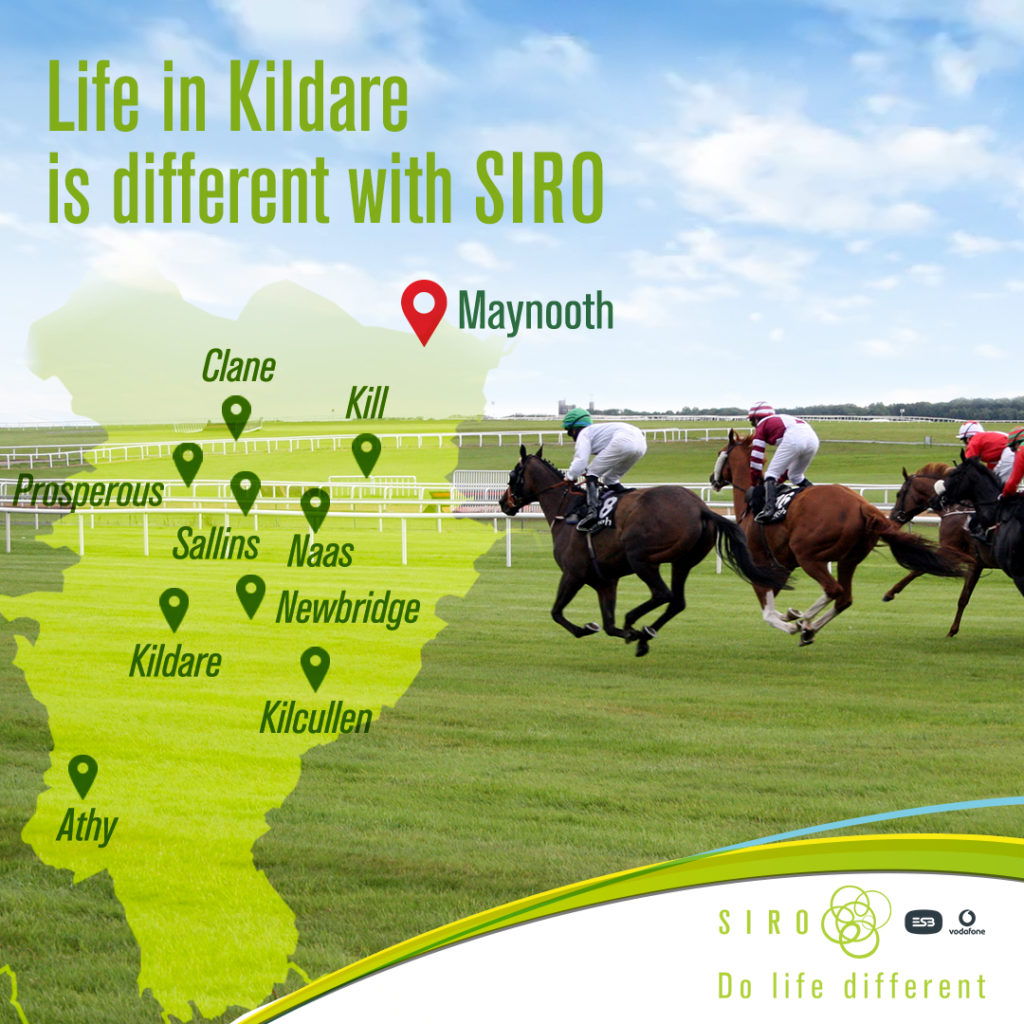 SIRO is a joint venture company between ESB and Vodafone, founded in 2015. SIRO’s state-of-the-art fibre broadband network is built on the ESB electricity infrastructure, trusted for its reliability and resilience. Overall, the company is investing more than €1 billion in delivering high speed, future proofed broadband across Ireland.
Commenting on SIRO’s launch in
SIRO is a joint venture company between ESB and Vodafone, founded in 2015. SIRO’s state-of-the-art fibre broadband network is built on the ESB electricity infrastructure, trusted for its reliability and resilience. Overall, the company is investing more than €1 billion in delivering high speed, future proofed broadband across Ireland.
Commenting on SIRO’s launch in  With the rush to the beach or getting time away after two years of COVID-induced lockdowns, you might have missed the news of Amazon’s most recent acquisition this summer.
On 21 July,
With the rush to the beach or getting time away after two years of COVID-induced lockdowns, you might have missed the news of Amazon’s most recent acquisition this summer.
On 21 July,  Amazon’s SVP of Health Services, Neil Lindsay, summed up the opportunity when he noted:
Amazon’s SVP of Health Services, Neil Lindsay, summed up the opportunity when he noted:
 Yet healthcare, particularly patient experience of accessing care, remains one of the few sectors where the impact of connectivity and digital technologies doesn’t appear to have made as much cut through.
While most activities can be booked online such as a haircut or an NCT for a car, why not an appointment with a GP? Equally, in Ireland’s hospital system there is no single digital health record for each patient to provide a catch-all record of a patient’s lifelong medical history. Instead, 85% of all hospital records remain paper-based and hospitals can’t access GP data and vice versa.
Yet healthcare, particularly patient experience of accessing care, remains one of the few sectors where the impact of connectivity and digital technologies doesn’t appear to have made as much cut through.
While most activities can be booked online such as a haircut or an NCT for a car, why not an appointment with a GP? Equally, in Ireland’s hospital system there is no single digital health record for each patient to provide a catch-all record of a patient’s lifelong medical history. Instead, 85% of all hospital records remain paper-based and hospitals can’t access GP data and vice versa.
 Integrated Services Digital Network (ISDN) first began to be used globally in the 1980s. It is effectively a set of communication standards for simultaneous digital transmission of voice, video, data and other network services over the digitalised circuits of the public telephone network. However globally, even by the end of the 1980s, the technology was already being overtaken by new network systems with much faster speeds.
However, not so the case in Ireland. Here, ISDN was introduced and billed as a step change in the digitalisation of the telephone network by Telecom Eireann in 1994, with the promise of multiple direct dial numbers (DDIs) over a single shared bearer. Originally, its capability to communicate video was also a key selling feature, with one of the original users of ISDN in Ireland being Gairmscoil Éinne on Inis Mór where pupils received their German lessons from a teacher on the mainland.
Integrated Services Digital Network (ISDN) first began to be used globally in the 1980s. It is effectively a set of communication standards for simultaneous digital transmission of voice, video, data and other network services over the digitalised circuits of the public telephone network. However globally, even by the end of the 1980s, the technology was already being overtaken by new network systems with much faster speeds.
However, not so the case in Ireland. Here, ISDN was introduced and billed as a step change in the digitalisation of the telephone network by Telecom Eireann in 1994, with the promise of multiple direct dial numbers (DDIs) over a single shared bearer. Originally, its capability to communicate video was also a key selling feature, with one of the original users of ISDN in Ireland being Gairmscoil Éinne on Inis Mór where pupils received their German lessons from a teacher on the mainland.
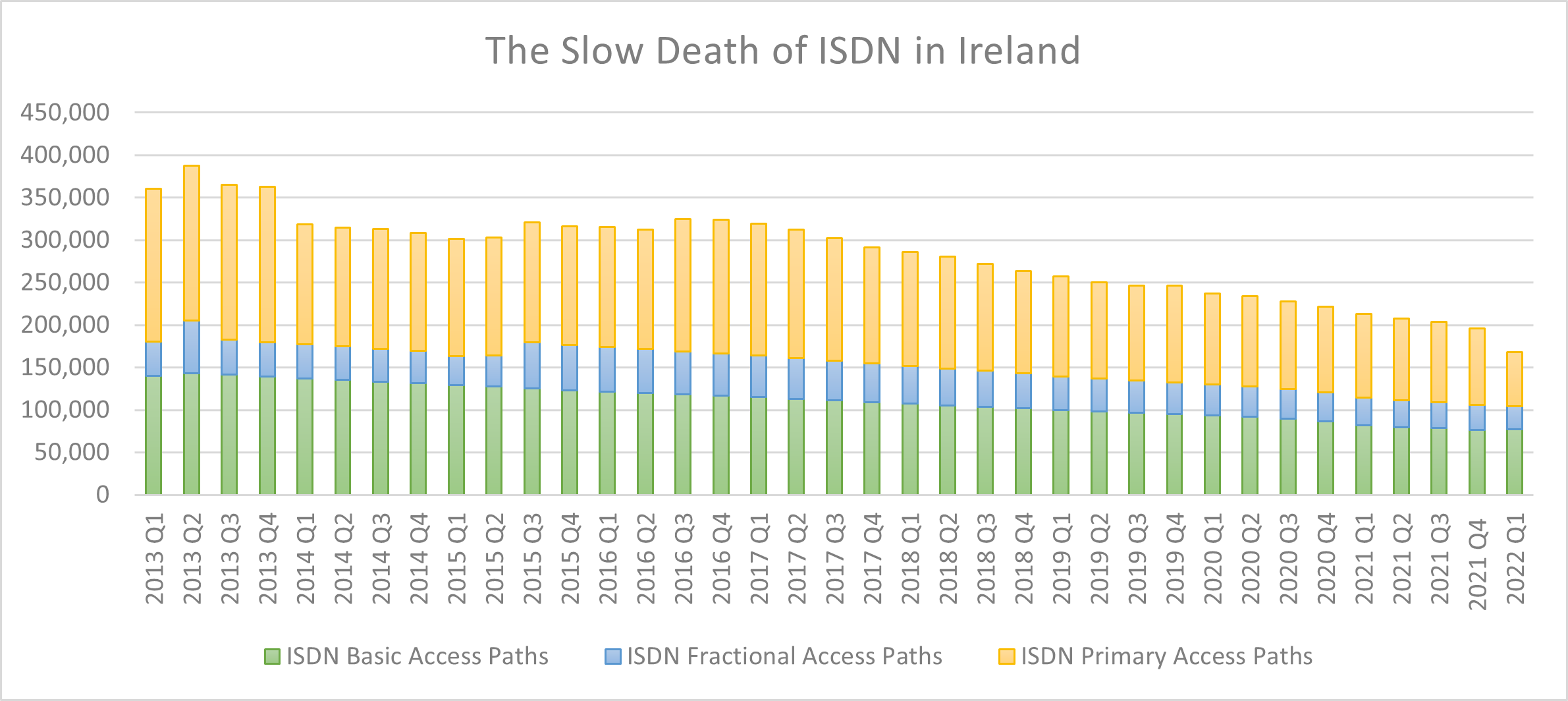 From 2017 onwards the changes in Enterprise Networks and Solutions Architecture have impacted heavily on the use of ISDN access paths.
Those key changes include:
From 2017 onwards the changes in Enterprise Networks and Solutions Architecture have impacted heavily on the use of ISDN access paths.
Those key changes include:
 SIRO’s Employee Experience Manager and Executive Assistant to the CEO (Chief Executive Officer), Gillian Quigley, explores digital wellbeing apps, mental health, and the importance of staying connected.
They say these days that there’s an app for everything. An app to order food or clothes, to stream your favourite shows, and even to adjust the temperature within your home. But what about an app to improve your mental health? General wellbeing and morale over the course of the past three years has naturally dipped because of strict restrictions, lockdowns and varying levels of anxiety within society. People yearned for diverse ways to connect when the effects of loneliness in Ireland was higher than ever before.
SIRO’s Employee Experience Manager and Executive Assistant to the CEO (Chief Executive Officer), Gillian Quigley, explores digital wellbeing apps, mental health, and the importance of staying connected.
They say these days that there’s an app for everything. An app to order food or clothes, to stream your favourite shows, and even to adjust the temperature within your home. But what about an app to improve your mental health? General wellbeing and morale over the course of the past three years has naturally dipped because of strict restrictions, lockdowns and varying levels of anxiety within society. People yearned for diverse ways to connect when the effects of loneliness in Ireland was higher than ever before.  SIRO, like other companies provide apps to augment our support resources. However, you may choose to research, evaluate and use your own preferred option. There are many popular and affordable apps that don’t require intervention from your workplace. Some of these apps include ,
SIRO, like other companies provide apps to augment our support resources. However, you may choose to research, evaluate and use your own preferred option. There are many popular and affordable apps that don’t require intervention from your workplace. Some of these apps include ,  In acknowledging that digital wellbeing apps are a natural progression for health services, with more services coming online each day, it’s important to ensure that your home or business is prepared for this evolution. SIRO’s fibre to the premises broadband is a ‘one size fits all’ type of connectivity that’s resilient enough to handle any video calls, heavy data uploads without a break in signal, when using cloud-based health platforms.
The pandemic has shown us that connectivity matters now, more than ever before. Staying connected with your friends, family and your own self is vital to having a positive, healthy state of mind.
If you or someone you know are experiencing mental health issues, please contact:
In acknowledging that digital wellbeing apps are a natural progression for health services, with more services coming online each day, it’s important to ensure that your home or business is prepared for this evolution. SIRO’s fibre to the premises broadband is a ‘one size fits all’ type of connectivity that’s resilient enough to handle any video calls, heavy data uploads without a break in signal, when using cloud-based health platforms.
The pandemic has shown us that connectivity matters now, more than ever before. Staying connected with your friends, family and your own self is vital to having a positive, healthy state of mind.
If you or someone you know are experiencing mental health issues, please contact: